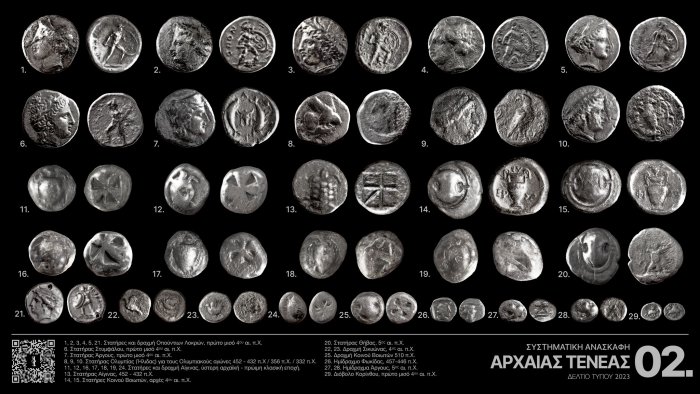Jan Bartek - AncientPages.com - During archaeological excavations in Tenea, an ancient Greek town near Corinth, built by Trojan prisoners of war, scientists unearthed a wonderful treasure and intriguing ancient ruins.
Credit: Ministry of Culture
The excavations at the site, located approximately 80 kilometers southwest of Athens, gave archaeologists an excellent opportunity to find and study a portion of the Hadrianic aqueduct that supplied water to the ancient city of Corinth from Stymphalus.
According to a statement issued by the Ministry of Culture, the unearthed aqueduct near the Roman baths along the Karkana River is one of Greece's largest hydraulic works of the 2nd century AD. Archaeologists managed to excavate about 31 meters in a north-south direction. Based on preliminary studies, researchers could determine the structure has external vertical walls that are 3.20 meters in height.
The unearthed treasure consists of 29 silver ancient Greek coins dating from the late 6th century. Many of the coins are extremely rare and have been praised as the most historic coins of ancient Greece. The coins were found in the vicinity of a portable clay altar, miniature vase, and horse riding statue.
Credit: Ministry of Culture
The area was inhabited before the fall of Troy, the Ministry of Culture said in a press release. The coins include three staters of Elis minted at Olympia during different Olympic Games, staters of Aegina with a land instead of a sea turtle, staters of Stymphalos, Argos and Opuntia Lokron, as well as staters of Thebes from the 5th c. B.C. depicting Hercules suffocating two snakes with his hands.
Experts explained the unearthed rich building complex from the late Archaic times to the Hellenistic times was most likely a cult site. The presence of the treasure in question is linked to the finds of cult use (female and animal figurines, miniature vases, and others) that were identified last year and continued to be identified this year, giving a clear ritual character to the areas that are revealed.
Credit: Ministry of Culture
Credit: Ministry of Culture
Credit: Ministry of Culture
Credit: Ministry of Culture
Credit: Ministry of Culture
Archaeologists also examined Roman and late Roman buildings along with carved archaic tombs and other Roman tombs decorated with rich geometric and animal motifs. These tombs belong to both adults and children.
According to Greek mythology, Tenea was established by Trojan prisoners of war, to whom King Agamemnon granted permission to build their settlement after the Trojan War.
The ancient city of Tenea was long considered to be mythical. However, some years ago, scientists found underwater ruins of the Biblical city of Corinth. In 2018, archaeologists reported they had discovered the ancient city of Tenea, which had not been submerged.
See also: More Archaeology News
The archaeological finds from the prehistoric settlement of Tenea, dating to the Early Bronze Age II (2,600 – 2,300 B.C), were discovered by a research team led by archaeologist Dr. Elena Korka and conducted by the Directorate of Prehistoric and Classical Antiquities of the Ministry of Culture.
Written by Jan Bartek - AncientPages.com Staff Writer








